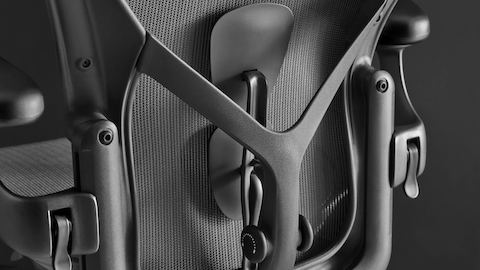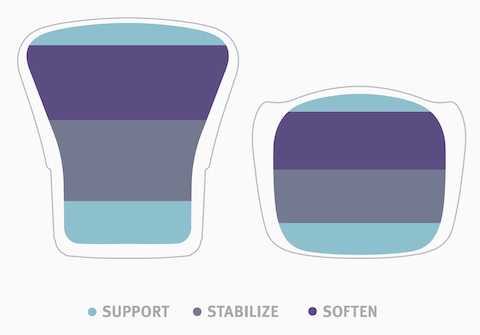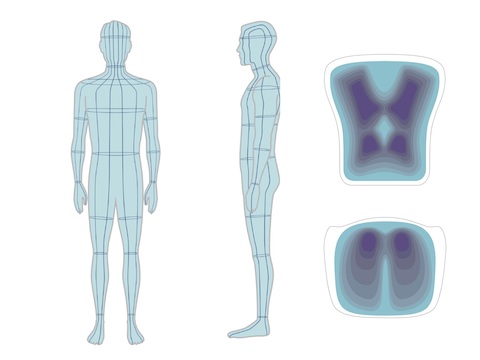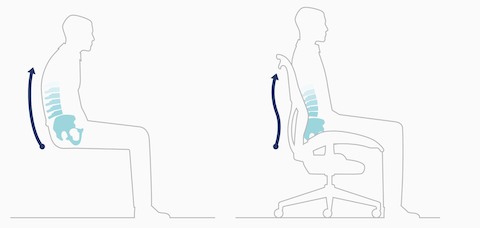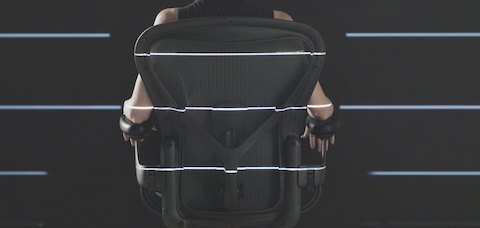Innovations in Supported Sitting
Download PDF (2.75 MB)
Key Insights
- Unsupported sitting leads to a static, slouched posture that can cause physical pains and, consequently, negative cognitive effects.
- A healthy seated posture is marked by a properly supported sacrum to stabilize the pelvis and the lumbar spine combined with appropriately distributed pressure.
- Aeron’s PostureFit SL—an update to the innovative 2002 sacral support mechanism—and 8Z Pellicle—a new zonal approach to our trademark suspension material—combine to combat the harmful effects of prolonged sitting.
Nearly 80 percent of all people in the United States complain of back pain.1 The Center for Disease Prevention reports that when employees suffer from work-related musculoskeletal disorders, they can miss an average of 20 work days per year. The Center also reports that the annual cost of such disorders is $45-54 billion.2 Ergonomic seating solutions can minimize these costs and also increase productivity by properly supporting the back and encouraging healthy posture.
The Posture Committee of the American Academy of Orthopedic Surgeons defines healthy posture as “skeletal alignment refined as a relative arrangement of the parts of the body in a state of balance that protects the supporting structures of the body against injury or progressive deformity.”3 Researchers in the peer-reviewed medical journal Physiotherapy Theory and Practice furthered this notion, writing, “In sitting, there is no one ideal posture, nor should one posture be sustained. Healthy sitting posture, therefore, is best thought of as an active, not a static phenomenon.”4
Dr. Brock Walker, an expert on musculoskeletal disorders, points out that comfort is a critical aspect of sitting and is completely rooted in a supported posture. He notes that no one sits in an unsupported position comfortably for very long. Movement is human nature, and moving between supported positions helps the muscular and skeletal systems. It also helps mental stamina and the ability to concentrate. The neck, shoulder, and back discomfort that accompany a slouched, static posture not only cause physical pains but can also have negative mental effects.
Sitting, however, is inevitable. Bill Stumpf and Don Chadwick knew this when they combined their deep knowledge of human-centered design, ergonomics, and materials in 1994 to create the classic Aeron Chair. The remastering of the Aeron Chair in 2016 is a prime example of how Herman Miller, with the help of experts such as Dr. Walker, develops chairs using proprietary materials and mechanisms that enable people to experience a healthier seated posture. Made possible by advancements in materials, manufacturing, and technology, the enhanced Aeron advances the chair’s ability to reduce pressure points, respond to the body’s micro-movements, and support the sacral and lumbar regions of the spine in order to combat the harmful side effects of prolonged sitting.
Zonal Support
The classic Aeron Chair was the first to replace traditional foam and fabric construction with a breathable, elastomeric woven suspension material—the proprietary performance textile known as Pellicle—which revolutionized sitting by allowing efficient micromovements and altering the distribution of pressure in the seat and backrest. As technologies advanced and Herman Miller ergonomists and researchers learned more about the science behind Pellicle, it became clear that targeting specific areas of the body for more support and relieving pressure in others can make sitting even more healthful and comfortable.
While the original Pellicle redistributed pressure on a suspension fabric with uniform tension and material stiffness, the updated version, called 8Z Pellicle, has eight specific zones with varying tension and stiffness—four in the seat and four in the backrest. 8Z Pellicle improves comfort and performance by targeting specific anatomical zones with different levels of firmness to deliver three physical objectives: support, stabilize, and soften.
Throughout the seat and backrest, the varied zones engage the body at key locations such as the pelvis and sacrum to carry most of the users’ weight in a healthy seated posture. The support zones at the top and bottom of the backrest and front and back of the seat deflect the body to encourage a supported posture. The stabilize zones engage the body at its flexible regions, such as the lumbar spine, to assist alignment and still allow healthy movement. The softened zones engage the body at peak pressure locations such as the sit bones and shoulder blades to relieve pressure points and contour and nest the body. Together the eight zones deliver the performance the body needs to stay active and comfortable throughout the day.
Proving the Material Science
In order to quantitatively examine the differences resulting from the updates to Aeron’s Pellicle suspension material, Herman Miller asked the University of Michigan Transportation Research Institute (UMTRI) to complete a laboratory study of people sitting in both the classic and enhanced Aeron Chairs. Herman Miller asked UMTRI to use an innovative method to objectively measure the updates to the Aeron Chair.
UMTRI has been using 3D surface modeling for more than a decade to understand human body shapes and interactions with design. The team has scanned soldiers in their gear and personal protective equipment to understand their interactions within a combat vehicle. They have also used the method in automotive seating applications. This was the first time, however, that they applied the technique to task seating.
To measure the effects of the 8Z Pellicle, participants with a wide range of body sizes were measured sitting in both upright and reclined positions. Standard measurements of body dimensions were augmented by three-dimensional, whole-body surface scanning of each participant. Researchers measured seat surface pressure and surface contour data of the seat and backrest as participants sat in both the classic and remastered Aeron Chairs.
By applying this innovative research method, mixing pressure mapping and 3D scans, researchers were able to quantify the differences in contour and pressure distribution produced by the 8Z Pellicle. The data showed that, as the designers intended, the 8Z Pellicle surface was flexing more under the buttocks and upper back than the original Pellicle. Additionally, the 8Z Pellicle at the top and bottom of the backrest and front and back of the seat showed less flex than the original Pellicle material because 8Z was designed to provide firmer support in that region. This variation in flex in the appropriate regions provides the support that is needed to improve users’ sitting experience.
PostureFit Reimagined
As a person moves from standing to sitting, the pelvis rotates rearward. Because the pelvis is attached to the sacrum and the sacrum is connected to the lumbar spine, any rotation of the pelvis influences the shape of the lumbar spine.5 The sacrum serves as the foundation for the entire spine, lying just beneath the lumbar and attaching to it by way of the L5/S1 joints and soft tissue structures.
When a person sits without adequate lower back support, relaxing the back muscles causes the pelvis to rotate rearward and the lumbar spine to flex into a kyphotic, or outward, curve. In this slouched posture, the tissues of the lumbar spine are under higher stress than when they are properly supported, leading to fatigue, spinal disc compression, and general discomfort.
In 2002, Herman Miller and Dr. Walker collaborated on the addition of a patented sacral support device, PostureFit, to the classic Aeron Chair in order to promote natural, unforced spinal alignment and muscle balance. It does so in any seated position by adjusting to fill the void between the contours of the sacral region and the chair backrest. Although the industry has focused on solving spinal curvature by only supporting the lumbar, healthful spinal alignment starts at the sacrum.
The remastered Aeron offers an advancement in PostureFit called PostureFit SL. It has adjustable, individual pads that both stabilize the sacrum and support the lumbar region of the spine to provide full spinal stabilization from the base of the sacrum through the upper thoracic region. Because sacral-pelvic dimensions are similar, even across a wide range of body sizes, the sacral pad is equally beneficial for all body types and sizes, without the need for height adjustability. The lumbar pad similarly doesn’t require height adjustability, as its vertical nature accommodates for a large anthropometric range.
Both pads flex individually, with the sacral pad moving first and driving the movement of the lumbar pad to support the upper lumbar spine. When these pads simultaneously support the sacral and lumbar regions of the back, the entire S-shape of the lumbar spine is nurtured.
Total Back Support Through 8Z Pellicle and PostureFit SL
Because people will try to avoid sitting in uncomfortable positions for long periods of time, physical pain, an inability to focus, and low performance are the norm in a chair with poor back support. Herman Miller—continually asserting our leadership and authority in ergonomics and design—knew it could further combat these problems by updating Aeron’s design with the latest research and advancements in materials, manufacturing, and technology.
The advanced PostureFit SL and new 8Z Pellicle offer calculated, localized reinforcement designed to move the skeletal system into the right position, correctly support key back muscles, and encourage the body’s natural micro-movements. This result is properly distributed support, a stabilized sacrum and supported lumbar region, and ultimately, a more healthful sit.
As Dr. Walker noted, “It’s the interdependent system that provides identifiable support, stabilization, and comfort for the near limitless movements and contours of the human body.” The 8Z Pellicle zones in the lower back complement the PostureFit SL, all of which properly position the spine and pelvis to stay healthy and active throughout the day. The combination of these key updates combats the harmful effects of prolonged sitting, delivering the support your body needs to avoid physical issues like fatigue, spinal disc compression, and general discomfort. These improvements can lead to happier, healthier employees, as well as more productive organizations and savings resulting from a decrease in work-related musculoskeletal disorders.
Notes
1. Andersson, Gunnar Bj. "Epidemiological features of chronic low-back pain." The Lancet 354, no. 9178 (1999): 581-85. doi:10.1016/s0140-6736(99)01312-4.
2. Centers for Disease Control and Prevention. https://www.cdc.gov/.
3. AAOS. http://www.aaos.org/.
4. Pynt, Jenny, Joy Higgs, and Martin Mackey. "Seeking the optimal posture of the seated lumbar spine." Physiotherapy Theory and Practice 17, no. 1 (2001): 5-21. doi:10.1080/09593980151143228.
5. Chaffin, D.B., Andersson, G.B.J., & Martin, B.J. (1991). Occupational Biomechanics, Wiley-Interscience.
